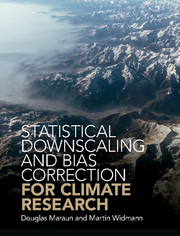Book contents
- Frontmatter
- Dedication
- Contents
- Preface
- Acknowledgements
- 1 Introduction
- Part I Background and Fundamentals
- 2 Regional Climate
- 3 History of Downscaling
- 4 Rationale of Downscaling
- 5 User Needs
- 6 Mathematical and Statistical Methods
- 7 Reference Observations
- 8 Climate Modelling
- 9 Uncertainties
- Part II Statistical Downscaling Concepts and Methods
- Part III Downscaling in Practice and Outlook
- Appendix A Methods Used in This Book
- Appendix B Useful Resources
- References
- Index
8 - Climate Modelling
from Part I - Background and Fundamentals
Published online by Cambridge University Press: 27 December 2017
- Frontmatter
- Dedication
- Contents
- Preface
- Acknowledgements
- 1 Introduction
- Part I Background and Fundamentals
- 2 Regional Climate
- 3 History of Downscaling
- 4 Rationale of Downscaling
- 5 User Needs
- 6 Mathematical and Statistical Methods
- 7 Reference Observations
- 8 Climate Modelling
- 9 Uncertainties
- Part II Statistical Downscaling Concepts and Methods
- Part III Downscaling in Practice and Outlook
- Appendix A Methods Used in This Book
- Appendix B Useful Resources
- References
- Index
Summary
Simulations with dynamical global climate models are the primary source of information about future climate and provide the input for statistical and dynamical downscaling methods. In this chapter, we give an overview on climate modelling. The level of detail is chosen such that the reader can gain a fundamental understanding of the basic principles; being comprehensive on technical aspects is not the purpose. Introductory texts on climate modelling include McGuffie and Henderson-Sellers (2005), Barry and Chorley (2009), O'Hare et al. (2014). More detail can be found in Kalnay (2003), Neelin (2010), Holton and Hakim (2013), Stocker (2011), Goosse (2015) and comprehensive discussions of many aspects in Trenberth (1992),Washington and Parkinson (2005) and Satoh (2013).
We begin with a short presentation of the different types of climate models and simulation setups. Section 8.2 covers one typical example for the equations that are at the core of climate models. Section 8.3 summarises the most important aspects of numerical integration. Section 8.4 discusses the ways how unresolved processes are included through parameterisations, outlining the overall concept and going into more details for some aspects that are particularly important in the context of downscaling. The chapter is concluded by discussion of model performance, again with a focus on aspects that are most relevant for downscaling (Section 8.5).
Model and Simulation Types
Models are simplified versions of the real world. They are smaller than reality because the number of locations and variables (i.e. the dimensionality of the state space) is lower and because not all processes are represented. They are simpler because processes are included in a idealised way. Models are also closed, with only a few external forcing factors, whereas reality is open, with a large number of unpredictable, external forcings. There is a spectrum of models. Very simple, conceptual models only represent the most important processes, and their purpose is to aid understanding through simplifying complex systems. At the other end of the spectrum are quasi-realistic models, which are as complex and realistic as the process understanding and practical limitations allow. Global general circulation models (GCMs) and regional climate models (RCMs) are of this type. They can be used to make predictions for the future, as an experimental tool to test hypothesis about processes and to interpolate observations in a physically consistent way. Climate models include components for different parts of the real climate system.
- Type
- Chapter
- Information
- Publisher: Cambridge University PressPrint publication year: 2018



